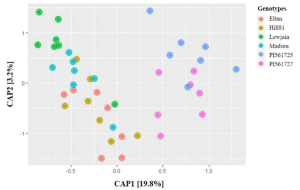A group from Department of Plant Pathology, Washington State University, Pullman, WA, USA, etc. has reported that wheat genotype and physiological stage shaped the microbiome, which was able to significantly alter soil suppression of pathogen R. solani AG-8.
https://pubmed.ncbi.nlm.nih.gov/34925393/
Microbiomes have drawn a great deal of attention and studies have begun focusing on manipulating these microbiomes in order to strengthen sustainable agricultural systems. In this context, genotype-specific recruitment of the microbiome is also gaining interest with the idea that host genotypes will attract bacteria with specific outcomes in different agroecosystems.
In this study, rhizosphere microbiome recruitment of six winter wheat genotypes (Eltan, Madsen, Hill81, Lewjain, PI561725 and PI561727) under growth chamber conditions were evaluated and have been found to be genotype-specific with increasing growth chamber daycicles. At 160-daycyles, microbiomes of PI561725 and PI561727 were clearly differentiated from others as shown below.

As aresult, differential abundance of Burkholderiales OTUs, specifically the genus Janthinobacterium in PI561727 and PI561725 cultivated soils, was associated with reduced root disease and better wheat growth. It is known that Burkholderiales OTUs could be a putative biological control agent against pathogen R. solani AG-8. Thus, using an appropriate wheat genotype to manipulate the rhizosphere microbiome could provide a sustainable approach to manage soil-borne disease.
